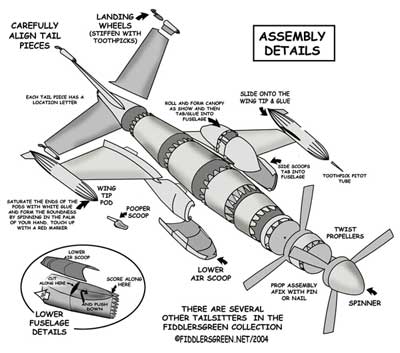


Lockheed XFV-1 Salmon VTOL
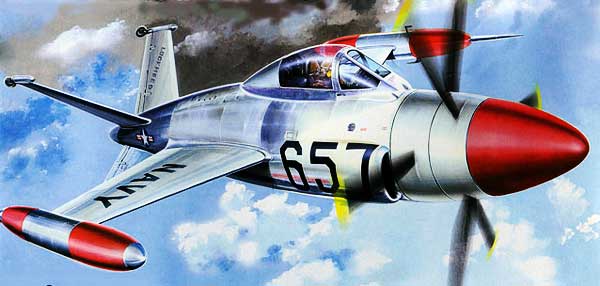
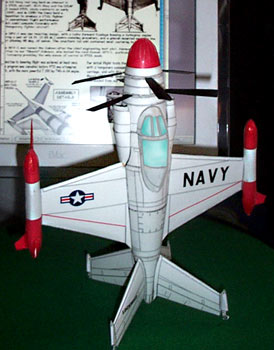
The US Navy and the USAF had issued VTOL study contracts as early as 1947, and in 1950 the Navy held a competition to produce a VTOL fighter with conventional flight performance which could compete favorably with contemporary fighter aircraft.
The XFV-1 was one resulting design, with a bulky forward fuselage housing a turboprop engine driving a pair of 16 ft. contra-rotating propellers, and a gimbal-mounted seat for the pilot allowing 45 deg. of swivel. The XFV-1 was named the after the chief engineering test pilot, Herman "Fish" Salmon. Neither he nor "Skeet's" Coleman, who tested the rival Convair XFY-1, particularly liked the powerful turboprop providing the only means of control in VTOL mode.
It meant that descent rate on landing could only be slowed by jiggling the throttle and trying to time the lag until the engine responded.
For initial flight tests the XFV-1 was fitted with a temporary conventional fixed undercarriage, and with this made its first flight in March 1954. Transition to hovering flight was achieved at least once.
Along with large and regular sized versions, his kit includes a downloadable set of "training wheels".
I knew "Fish" Salmon also, his son Randy "Scooter" and I worked together to get our Flight Instructor ratings at Van Nuys Airport in California. We were active volunteers as pylon judges and timers for the Professional Race Pilots Association for the Mojave Air Races. Both Fish and Randy are gone now. Lots of fond memories. Thanks,....Bob
Download complete and successful. What a Wake-up call this morning! Waiting for me on the 'net it was. Just as you said. I cannot call the "Salmon" a real cutie, but your model certainly is. Again, the drawings on the instruction sheet are clear and will be a big help. And thank you for the optional conventional landing gear. Thanks again. JT
Lockheed XFV-1 Salmon VTOL
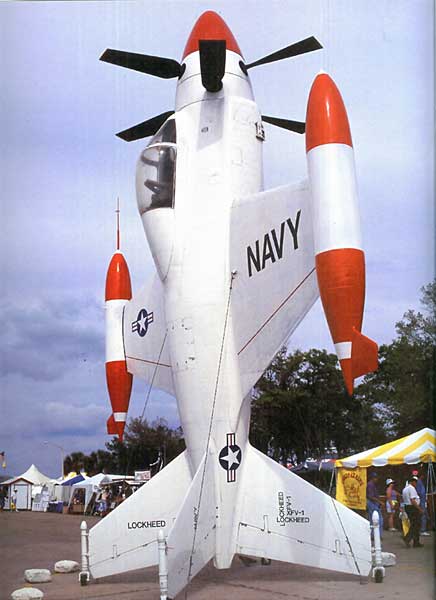
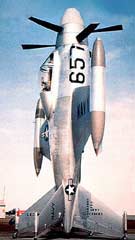 The Lockheed XFV-1 was an experimental
vertical takeoff aircraft of the 1950s. It was a result of a proposal
issued by the Navy in 1948 for an aircraft capable of vertical
takeoff and landing (VTOL) aboard platforms mounted on the afterdecks
of conventional ships. In 1950, this requirement was revised to
call for a research aircraft capable of eventually evolving into
a VTOL ship-based convoy escort fighter. On April 19, 1951, two
prototypes were ordered from Lockheed under the designation XFO-1.
The company designation was Model 081-40-01. Serials were BuNo
138657 and 138658. A similar aircraft was also ordered from Convair
under the designation XFY-1.
The Lockheed XFV-1 was an experimental
vertical takeoff aircraft of the 1950s. It was a result of a proposal
issued by the Navy in 1948 for an aircraft capable of vertical
takeoff and landing (VTOL) aboard platforms mounted on the afterdecks
of conventional ships. In 1950, this requirement was revised to
call for a research aircraft capable of eventually evolving into
a VTOL ship-based convoy escort fighter. On April 19, 1951, two
prototypes were ordered from Lockheed under the designation XFO-1.
The company designation was Model 081-40-01. Serials were BuNo
138657 and 138658. A similar aircraft was also ordered from Convair
under the designation XFY-1.
Work on the project began in August of 1950. Soon after the contract award, the designation was changed to XFV-1, when the manufacturer's code for Lockheed was changed from O to V. The XFV-1 sat on its tail for landings and takeoffs. It had a short and squat fuselage with tapered broad-chord short span wings with pods at the extreme tips. The aircraft sat on the runway in the vertical position, resting on equal-span cruciform tail surfaces, each having a fully-castoring strut and wheel at their tip. At takeoff, the engines ran up to full power and the aircraft ascended vertically, then when it reached a safe altitude it gradually nosed over into conventional horizontal flight. At landing, the aircraft approached the landing pad while pitched up into a nose-high position and then descended to the ground under gradually reduced power.
The XFV-1 was powered by a Allison YT40-A-6
turboprop (which consisted of a pair of coupled T38 turbines)
driving a pair of three-bladed contra-rotating 3-bladed propellers
in the nose. The engine offered a power of 5500 shp. The air intakes
for the engines were on the edges of the forward fuselage, and
the exhaust was on the bottom of the rear fuselage. The single
pilot sat underneath a cockpit canopy which slid toward the rear.
Entry to or exit from the cockpit required a special ladder, and
was by all accounts was rather awkward.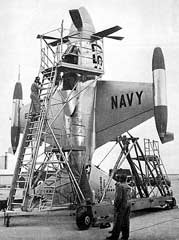
The first prototype (Bruno 138657) was ready by late 1953. Since the XT40-A-6 engine was deemed not sufficiently powerful for sustained vertical flight, the aircraft was first flown in conventional horizontal mode. For this, a temporary non-retractable undercarriage with long braced V legs was attached to the fuselage, and fixed tail wheels were attached to the lower pair of fins. In this form, the aircraft was trucked out to Edwards AFB in November of 1953 for ground testing and taxiing trials. During one of these tests, at a time when the aft section of the large spinner had not yet been fitted, test pilot Herman "Fish" Salmon managed to taxi the aircraft past the liftoff speed, and the aircraft made a brief hop on December 23, 1953. It would be several months before the engine was ready for the first official flight, which finally took place on June 16, 1954.
Full VTOL testing awaited the availability of the 7100 shp YT40-A-14. Unfortunately, this engine never materialized, and the XFV-1 never actually made any vertical takeoffs or landings. However, it did make a few transitions in flight from the conventional to the vertical flight mode and back, and had briefly held in hover at altitude. All flights at Edwards AFB were made with the lightweight spindly undercarriage.
In the meantime, delays in the development of the T40 engine had caused the Navy to change its mind and to downgrade the XFV-1 to a pure research vehicle, since its top speed was now too slow for a fighter. In June of 1955 the program was cancelled. After cancellation, the first XFV-1 was delivered to Hiller Helicopters of Palo Alto, California for ground testing. The second aircraft (Bruno 138658) was sent to NAS Los Alamitos where it was used as a gate guard. The first XFV-1 was donated to the San Diego Aerospace Museum.
The proposed production version was designated FV-2 (Model 181-43-02) and was to have been powered by the T54-A-16 turboprop, and was to have had a bullet-proof windshield, armor, and radar in the fixed forward part of the nose spinner. The proposed armament was four 20-mm cannon fitted in the two wingtip pods. Alternatively, 48 2 3/4-inch folding-fin rockets could be fitted.
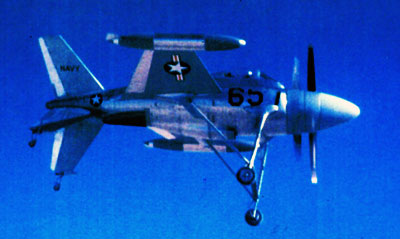
Specifications of Lockheed XFV-1:
Engines: One Allison XT40-A-6 turboprop, rated at 5500 shp. Projected performance with 6955 hp YT40-A-14: Maximum speed: 580 mph at 15,000 feet, cruising speed 410 mph.. Initial climb rate 10,800 feet/minute. Service ceiling 43,300 feet. Endurance was one hour, 10 minutes. at 35,000 feet. Weights: 11,600 pounds empty, 16,200 pounds loaded. Dimensions: wingspan 30 feet 10 7/64 inches (with tip tanks fitted), length 36 feet 10 1/2 inches, wing area 246 square feet. Armament was to have consisted of four 20-mm cannon or 48 2 3/4 FFARs in the wingtip pods.
The US Navy had long held an interest in the VTOL aircraft. Both they and the USAF had issued VTOL study contracts as early as 1947, and in 1950 the Navy held a competition to produce a VTOL fighter with conventional flight performance which could compete favorably with contemporary fighter aircraft. The XFV-1 was one resulting design, with a bulky forward fuselage housing a turboprop engine driving a pair of 16 ft. (4.88 M.) contra-rotating propellers, and a gimbal-mounted seat for the pilot allowing 45 deg. of swivel. The cruciform tail unit ended with castoring tail-wheels. The XFV-1 was named the Salmon after the chief engineering test pilot, Herman "Fish" Salmon. Neither he nor "Skeet's" Coleman, who tested the rival Convair XFY-1, particularly liked the powerful turboprop providing the only means of control in VTOL mode.
It meant that descent rate on landing could only be slowed by jiggling the throttle and trying to time the lag until the engine responded. For initial flight tests the XFV-1 was fitted with a temporary conventional fixed undercarriage, and with this made its first flight in March 1954. Transition to hovering flight was achieved at least once. The program was cancelled before vertical takeoff, with the proposed 7,100 hp T40-A-14 engine, could be attempted.
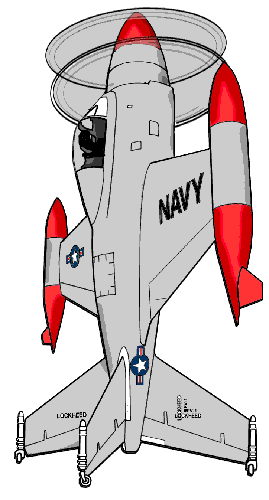
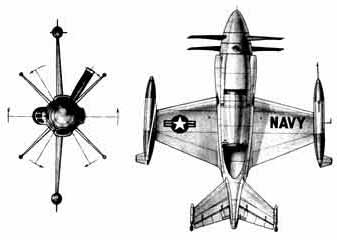 |
|
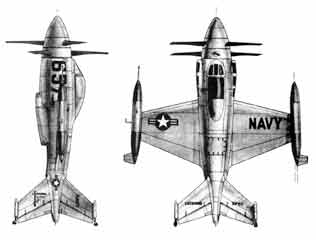 |
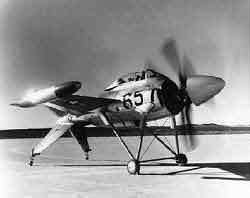
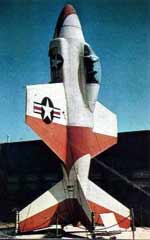
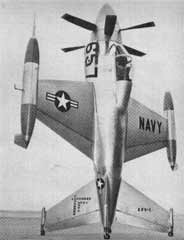
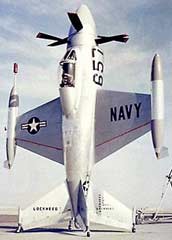
Specifications for the Lockheed XFV-1 Salmon
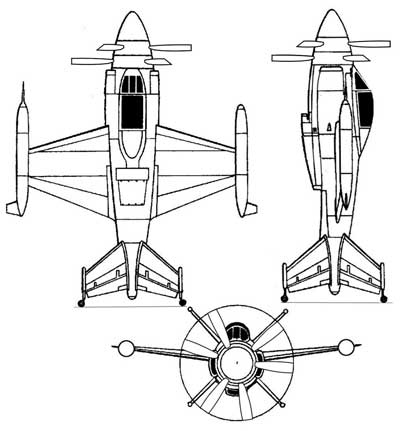 |
Length: 36 ft 10.25 in Wingspan: 30 ft 22 in Height: 36 ft 10.25 in Wing area: 246 ft² Empty weight: 11,599 lb Loaded weight: 16,221 lb Max takeoff weight: 16,221 lb Powerplant: 1x Allison YT40-A-6 turboprop, 5,850 hp Performance Maximum speed: 580 mph Cruise speed: 410 mph Service ceiling: 43,300 ft Rate of climb: 10,820 ft/min Wing loading: 65.9 lb/ft² Armament 4 × 20 mm (.79 in) cannons or 48 × 2.75 in (70 mm) rockets |



